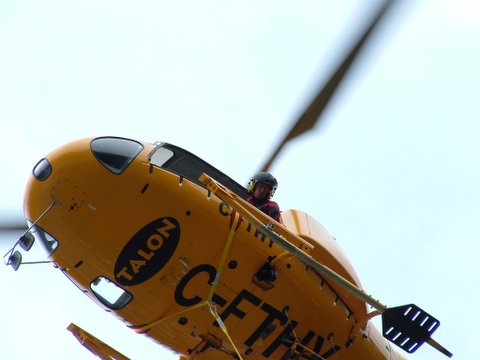Regarding communications networks in BC

From time to time I’ve offered interested parties the opportinuty to write guest posts on this blog. Today’s post is by Merrick Grieder, a member of Comox Valley SAR, Deputy Coordinator with the Comox Valley Emergency Program and Emergency Radio Communications volunteer.
Tim Jones, leader of North Shore Rescue, recently published a blog post titled “A Vision for Change for SAR in BC”.
He lays out three visions for improving SAR in BC, summarized as:
- Hasty team Standby pay
- Dedicated Helicopters for SAR
- A provincial communications system for SAR
I don’t have any issue with these ‘visions’ in principle but I wanted to comment on the 3rd item, a provincial communications system.
In his post, Mr. Jones states “A provincial communications system that mirrors Forestry . The current patch work system does not provide the effective safety net required for SAR operations in this province.”
I agree with this statement, but I don’t think we should have a SAR communications system that mirrors the Ministry of Forest Radio repeater network.
SAR should simply be granted access to use the forestry radio network in times of need.
With proper authorization and training in the correct procedures, SAR could make effective use of the extensive provincial network when needed, doing away with the need to construct a separate dedicated SAR radio network.
As the MFNLRO Radio Operations page states “When you are working out in the back country, sometimes alone, fighting forest fires and need to communicate or call for help, a fully functioning radio network is a must have service.”
Should SAR volunteers not be extended the same “must have” service?

As an amateur radio operator and RCM-SAR volunteer, I couldn’t agree more. It’s amazing that in order for ground units to talk to RCM-SAR boats they often have to talk to their police liaison, who in turn talks to JRCC, who then talks to MCTS, who then talks with RCM-SAR on scene. And then back the otherway. I know JDFSAR is getting some members certified with their marine licenses so they can communicate clearly and effectively. Not to mention, BCAS has had similar issues in the past.
I’m listening to the forestry repeater in Grand Forks right now and it’s very busy. I don’t think they would be able to share during fire season. Perhaps SAR should be granted use of the ham radio repeaters on the 2 metre band (144-148 MHz). The repeaters are not usually that busy and certainly could be used by SAR during emergency operations.
my 2 cents ;)
I agree the forestry service radio system would work well outside of fire season, but the chances of having a search in a fire area would be rare, and there are other options, like airborne repeater etc. In most instances, I think the forestry radio service is functional, available, and already paid for. It’s been offered to PEP Air/ CASARA on an ad hoc basis, but we already have FM SAR and amateur frequencies available that work very well while airborne.
The communications issue hasn’t been managed well as the obvious has been ignored ( mostly because of lack of information and collaberation ) and some GSAR teams are only interested in creating a closed network.
As far as dedicated helicopters go…. That makes no sense. they are too expensive to maintain for single roll, and the Canadian armed forces has this in spades. Companies like Talon do an exceptional job on the rescue/recovery phase, and I’m sure the profit margin is modest at best, but the value is there. However the Military are the only ones that can do both search and rescue phase affectively. They have exceptionally trained spotters and exceptionally well trained SAR technicians that can be deployed almost anywhere.
When they are not readily available, the search phase for missing aircraft ( and rarely GSAR taskings) is done by fixed wing which is very affective and a 10th of the cost of a helicopter, which has no spotter training. The search phase is every bit as technical as the rescue/recovery phase as the flight pattern is very important, and I don’t care what anyone says, but it takes the right person, at the right time with the right angle, and the right lighting so spot a target. Cooperative or otherwise, and it is a perishable skill that requires practice. Once the target has been located, that would be a good time to spool up a civilian commercial helicopter with the SAR techs and do the extraction. That policy alone for all searches that require air support would probably cut the helicopter budget almost in half.
The discussions on UAV’s has been interesting, and I think there may be a use someday, but at the moment, the value isn’t there. They are no better in poor weather then any other aircraft, and it’s like looking through a straw. ( see previous comment on right person… Right place….. Etc.)
As far as paid volunteers, they wouldn’t be volunteers anymore, would they?
And the volunteers would be pissed.
Just like any business, there are many ways to improve cost effectiveness without jeopardizing efficiencies. It just takes team efforts, and reaching out to other resources to collberate and initiate.
Don’t get stuck on your own personal mountain, there are a lot of available resources willing to help.
F
@kermatt The situation you describe is ludicrous. May as well swim out to the RCM-SAR boat and have a chat. Station 60 has a handheld radio to contact GSAR on PEPCOORD, has your station looked into that?
@ivan SAR members who have an amateur certificate can make use of any amateur frequency they like for SAR use as it is covered under “public service”. The trick is getting your GSAR members amateur radio certified. We’ve been lucky in the Comox Valley as two of our SAR members can teach the amateur radio course. Whistler SAR, Central OK SAR and some others are making progress and tests in this area as well.
@Fred Some great points there, especially about the aircraft usage models.
—
Merrick, VA7VM
This brings up the old issue of a common channel to use for all emergency responders. In a recent call we had to fly a helicopter over to talk to BCAS (poor cell service in the Kootenays) to determine next steps with subject. Almost as bad as having to swim out to a boat to talk. We have to believe that no matter how busy the fire season based on the low relative volume of communication and understanding of basic radio use and the use of simplex channels for line of sight communication that the established and maintained Forestry channels are the obvious answer. We use local logging company channels in our area when our fixed repeater is out of range. We believe that the forestry channels take that idea one step further and btw all the helicopters we use in our area have all of those channels programmed into their air craft. This seems like a quick fix to the aged old issue of communications on every SAR call I have ever been on. No extra cost to the Province so there is no negative effect on the tax payer and even better it is a better return on the investment because the segmented channels can be used by a larger base. Of all the ideas we have seen of late, this is one issue, we will stand behind 100% and beg the powers that be to pick up their pens (yes it will be that easy) and make it so. SARIF never did get moving I think forestry repeaters have a very good chance of being the emergency channel that all responders including parks and fire can use to provide aid to at risk people in our back country.